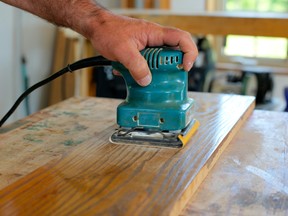
Reviews and recommendations are unbiased and products are independently selected. Postmedia may earn an affiliate commission from purchases made through links on this page.
Article content
q How should I finish a thick piece of elm wood that we want to add to an existing fireplace mantel? It comes from a tree cut from our property and sawn into wood.
Article content
TO Wood that is three or four inches thick can take a long time to dry. How long has it been since the log was ground? The only effective way to ensure sufficient drying for finishing is to store the wood in a fully heated space, perhaps for a year. As for the finish, you should start by sanding the wood until you get the same level of smoothness as the wood on the shelf. Apply interior wood stain, followed by a sealer coat to protect the wood from dirt. That said, there is a danger. You never really know what a stained and sealed wood surface will look like until the stain and all the layers of sealer are applied.
Advertisement 2
Article content
Ideally, you would complete the finishing process on a piece of elm that you want to use. Only then would you go ahead and finish the piece you want to install. This is more work, but it ensures that you won’t have any unpleasant visual surprises.
Urethane is a great option for sealing in your situation and I recommend a product with a satin sheen. It has almost no shine and hides imperfections better than a gloss urethane. Most urethanes are water-based these days and since this type dries so quickly, it often leaves bubbles and streaks.
One of the few non-water-based urethanes currently available is Varathane Pro Finisher. It is a solvent-based urethane that makes it easy to obtain excellent results. If you have had problems with urethane before, you won’t have any with this product. Apply one coat, let it dry completely, and then sand very lightly with 220-grit sandpaper, either by hand or with a 1/4-sheet finishing sander. This is a key step. Vacuum all the dust from the surface and then apply one more coat without sanding afterwards.

Mold control in the home
q We have been told we have mold in our attic. What are your thoughts on how to deal with this and how can you find a reliable company to clean things up?
Advertisement 3
Article content
TO Sometimes wood in attics can have dark stains due to mold that grew on the wood when it was stacked, and this type of mold is of no consequence. But in your case, what is the mold like? Who told you and what did you see?
The reason I ask is because professional mold removal can be very expensive and may not be necessary in your case. Mold almost always grows because there is enough moisture in some food source such as wood. Without humidity there is no mold. Have you had a roof leak that may be feeding mold? Condensation can sometimes build up in attics and cause mold, which encourages condensation in the winter.
If the mold is located in an area up to a couple of sheets of plywood, then you can fix it yourself (or have a handyman do it). After stopping the source of moisture, treat the area with a registered fungicide. The best one I know is called Concrobium. It is an odorless, non-toxic liquid that is sprayed on moldy areas. It works by mechanically crushing mold spores as it dries, so it doesn’t rely on any compounds toxic to people or pets. Concrobium not only kills mold, but also helps prevent its growth. If you have a significant attic mold problem, you will need professional help, but only after eliminating the source of moisture. You will probably need some type of construction professional for the moisture side, or an HVAC expert.
Steve Maxwell only likes mold on blue cheese. Visit him online at bailelylineroad.com and join the 31,000 people who receive his free email newsletter each week.
Article content
